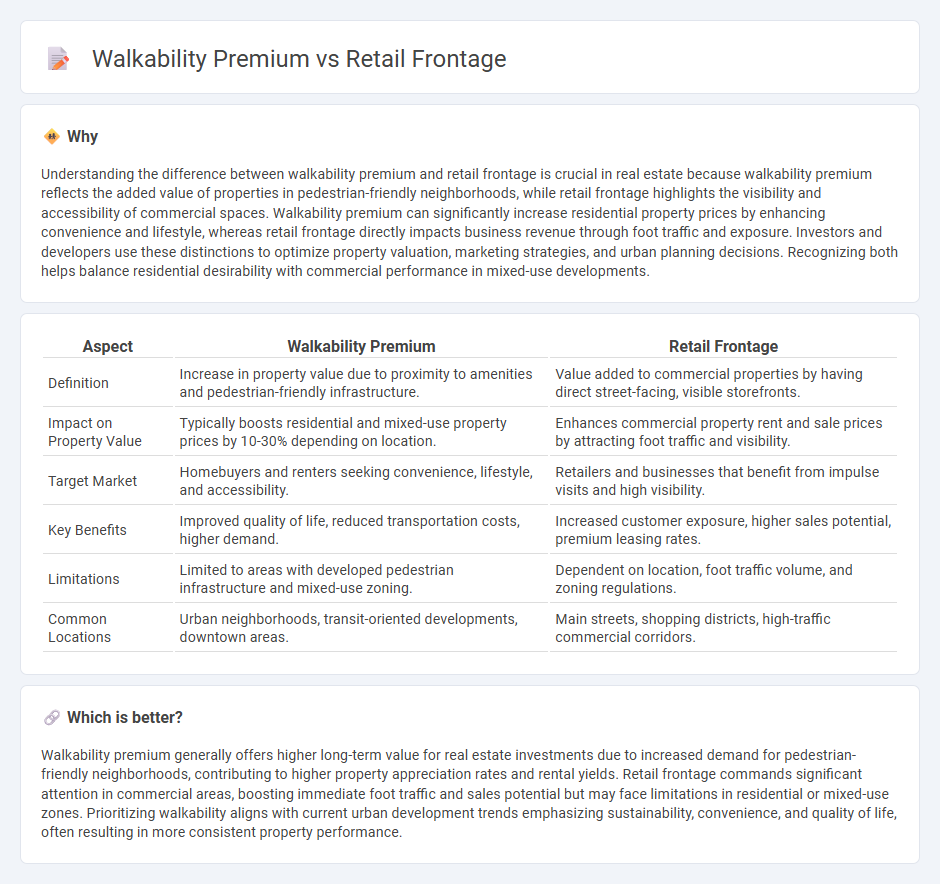
Walkability premium significantly increases property values by enhancing accessibility to amenities, public transit, and pedestrian-friendly environments, attracting residents seeking convenience and lifestyle quality. Retail frontage boosts commercial real estate appeal by increasing visibility, foot traffic, and sales potential for businesses located along busy streets with high consumer engagement. Explore how these urban features impact investment strategies and market dynamics in real estate.
Why it is important
Understanding the difference between walkability premium and retail frontage is crucial in real estate because walkability premium reflects the added value of properties in pedestrian-friendly neighborhoods, while retail frontage highlights the visibility and accessibility of commercial spaces. Walkability premium can significantly increase residential property prices by enhancing convenience and lifestyle, whereas retail frontage directly impacts business revenue through foot traffic and exposure. Investors and developers use these distinctions to optimize property valuation, marketing strategies, and urban planning decisions. Recognizing both helps balance residential desirability with commercial performance in mixed-use developments.
Comparison Table
| Aspect | Walkability Premium | Retail Frontage |
|---|---|---|
| Definition | Increase in property value due to proximity to amenities and pedestrian-friendly infrastructure. | Value added to commercial properties by having direct street-facing, visible storefronts. |
| Impact on Property Value | Typically boosts residential and mixed-use property prices by 10-30% depending on location. | Enhances commercial property rent and sale prices by attracting foot traffic and visibility. |
| Target Market | Homebuyers and renters seeking convenience, lifestyle, and accessibility. | Retailers and businesses that benefit from impulse visits and high visibility. |
| Key Benefits | Improved quality of life, reduced transportation costs, higher demand. | Increased customer exposure, higher sales potential, premium leasing rates. |
| Limitations | Limited to areas with developed pedestrian infrastructure and mixed-use zoning. | Dependent on location, foot traffic volume, and zoning regulations. |
| Common Locations | Urban neighborhoods, transit-oriented developments, downtown areas. | Main streets, shopping districts, high-traffic commercial corridors. |
Which is better?
Walkability premium generally offers higher long-term value for real estate investments due to increased demand for pedestrian-friendly neighborhoods, contributing to higher property appreciation rates and rental yields. Retail frontage commands significant attention in commercial areas, boosting immediate foot traffic and sales potential but may face limitations in residential or mixed-use zones. Prioritizing walkability aligns with current urban development trends emphasizing sustainability, convenience, and quality of life, often resulting in more consistent property performance.
Connection
Walkability premium significantly increases property values by enhancing accessibility and attracting foot traffic, which benefits retail storefronts through higher customer exposure. Retail frontage with visible and appealing facades directly leverages this premium by drawing pedestrians into stores, boosting sales potential and tenant quality. Properties located in highly walkable neighborhoods experience greater demand and rental yields due to this synergistic relationship between walkability and retail frontage.
Key Terms
Foot Traffic
Retail frontage significantly impacts walkability premiums by enhancing foot traffic, which directly influences sales potential and brand visibility. Areas with high retail frontage typically experience increased pedestrian flow, driving higher customer engagement and commercial value per square foot. Explore how optimizing retail frontage can maximize foot traffic and elevate your property's market appeal.
Visibility
Retail frontage significantly impacts visibility, directly influencing foot traffic and consumer engagement in urban environments. Walkability premiums enhance accessibility and shopper convenience, yet the prime determinant of sales often remains the retailer's visible storefront presence on high-traffic corridors. Explore strategies to optimize retail frontage and leverage walkability benefits for maximum commercial success.
Lease Rates
Retail frontage significantly influences lease rates, with properties featuring prominent street-facing windows commanding higher premiums due to increased visibility and customer traffic. Walkability premium also plays a crucial role, as retailers in highly walkable areas benefit from elevated foot traffic, leading to enhanced sales potential and justifying higher lease costs. Explore detailed analyses on how these factors shape retail lease rates to optimize your location strategy.
Source and External Links
Required Retail Frontage - This term refers to a specific requirement for retail spaces, where a minimum percentage of the frontage must be dedicated to retail uses, often enhancing the pedestrian-friendly environment.
Frontage Types - This document outlines various frontage types, including retail frontage, which is characterized by a facade aligned close to the frontage line with entrances at sidewalk level, often suitable for retail use.
3 Key Factors to Consider When Leasing Retail Space - Retail tenants prioritize frontage because it offers visibility and accessibility, making it crucial for attracting foot traffic and enhancing business visibility.
 dowidth.com
dowidth.com